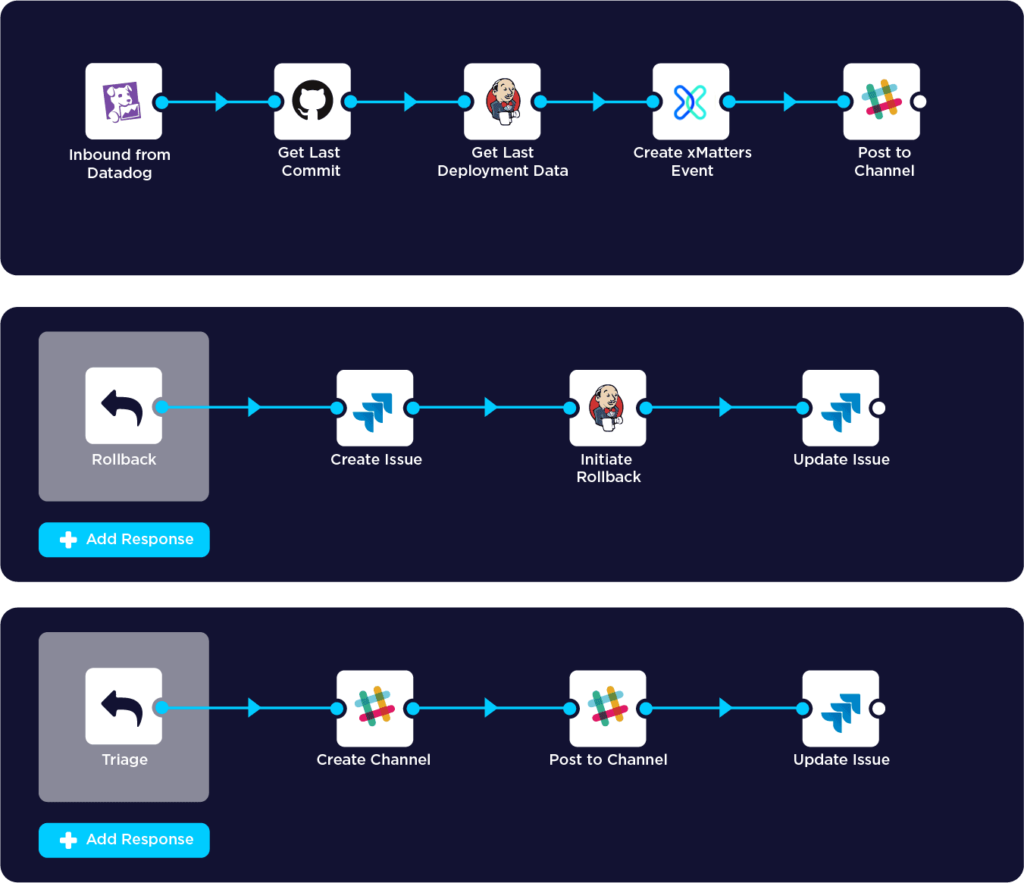Four Benefits of Integrating xMatters Into Your DevOps Toolchain

DevOps toolchains are an integral part of automating tasks and improving process efficiency. From SaaS to grocery stores, manufacturing, and even insurance brokers, a toolchain can make a positive impact on any business in any industry. But maybe you need something a little more granular to fully comprehend them and determine if the investment in the infrastructure and process mapping brings you the ROI you need.
When you step away to look at the big picture, there are a few standout benefits of integrating xMatters into your DevOps toolchains. Imagine the following benefits in the context of your organization—can you see how they would make a difference in your daily, weekly or quarterly operations?
Reduced Toil
Toil can be a burdensome obstacle for DevOps teams, especially when regular or routine issues persist despite attempts to remediate them. In essence, toil is when a solution or process requires manual intervention or repetitive steps to address common problems that are often a result of unaddressed technical debt.
For example, a team member rushing to meet a deadline may decide to use an open-source utility to integrate two tools instead of connecting them through an API. Doing so causes one of the tools to show an error message periodically, and the only way to ensure the solution is working reliably is for a team member to log in, check if there’s a message, and clear it.
xMatters can automate manual and repetitive work within your DevOps toolchain, reducing the toil a team has to perform on their own. Using the example above, an automated workflow could be set up in xMatters to monitor the system’s resources and notify the primary on-call support person whenever resource levels are in jeopardy. The notification recipient can then respond to the message to initiate other steps in the toolchain that will automatically clear the cache, record the action to a chat channel, and update the monitoring tool. By reducing the toil required to constantly monitor and fix the cache manually, the team can focus on addressing the underlying technical debt or prioritize further innovation.
Consistent, Guided Workflows
Processes that aren’t documented and practiced risk being forgotten. This can become increasingly worrisome for teams where issue remediation is complex and requires a high degree of precision to complete correctly. xMatters can help organize your DevOps toolchains to create consistent, guided workflows that simplify processes for teams and remove the need for manual or time-consuming processes.
Consider the below workflow. Here, we see three different beginning steps (or triggers) that could prompt xMatters to jump into action—first communicating to a person of contact, then initializing a number of secondary steps like launching Slack and starting a conference call.

Without xMatters in the DevOps toolchain, team members would be responsible for manually getting in touch with the right group of on-call resources to resolve the issue, create the communication channels, and find a solution. All these processes can take significant amounts of time, and if there’s a major incident at hand, there’s no time to waste trying to remember the right process.
Targeted Alerts
You may have noticed a recurring theme in the first two examples: the right people receiving notifications at the right time. Consider your current process for getting in touch with the right team members when an incident occurs; what does that look like? If there’s a server problem and your website goes down in the middle of the night, how do you know who to contact and on which device?
Targeted alerts are a significant benefit of xMatters and one that can’t be overlooked. Getting in touch with the right person, at the right time on the right device, can be the difference between an event causing a temporary issue or it causing a major outage that affects your entire network. With xMatters, your toolchain can have the correct on-call chain of command built-in, so when an alert needs to be sent there are no issues; more advanced workflows can also have contingencies set up, like time of day or temporary changes when a team member is on vacation. This means that not only is xMatters helping you manage problems in your toolchain, but it’s also getting the right people in on the problem to begin with.
More Uptime, Less Downtime
What do you get when you combine reduced toil, consistent workflows and targeted alerts? More uptime, less downtime.
During even the simplest incident, you have to collaborate by asking for help, updating relevant stakeholders, briefing the team, escalating the alert, and opening the right channels for communication. But a toolchain can connect all these tools for you so that while you’re focusing on starting to resolve the root cause, the toolchain is doing the manual work of creating communication channels, contacting resolvers, and getting other members of the team up to speed.
In all industries, time is money, and the longer your business is faced with an outage or other sort of downtime, the longer the business loses profits. Reducing the time to repair ensures that the business loses as little as possible, and keeps internal and external satisfaction at an all-time high.
As organizations look for ways to make processes more efficient, a DevOps toolchain can automate and simplify operations to become an integral part of any operations environment. To learn more about DevOps toolchains, make sure to read our article Do I Need a DevOps Toolchain? If you’re interested in a more hands-on approach, request a demo and discover all the ways it could make a positive impact on your business!
